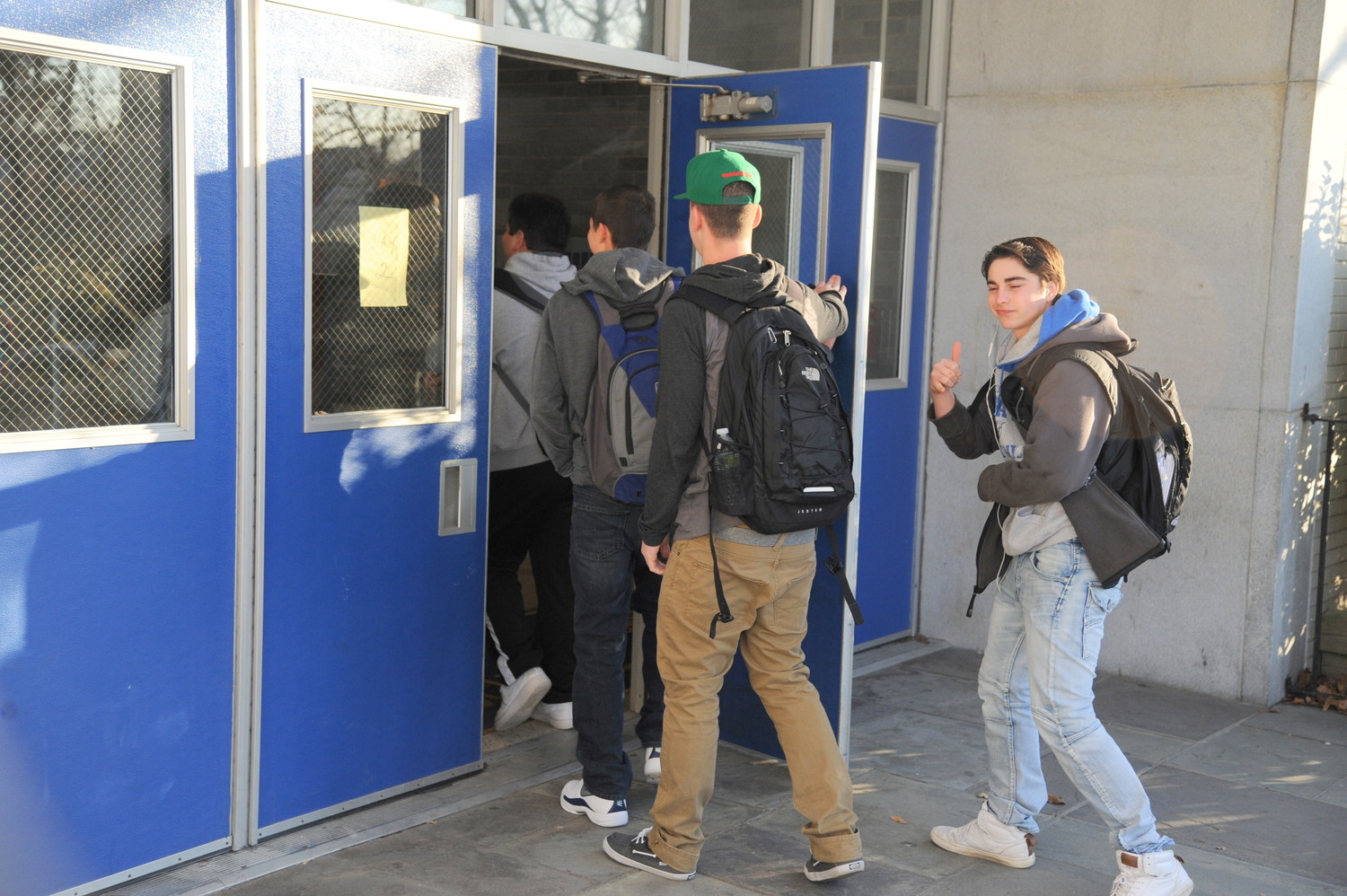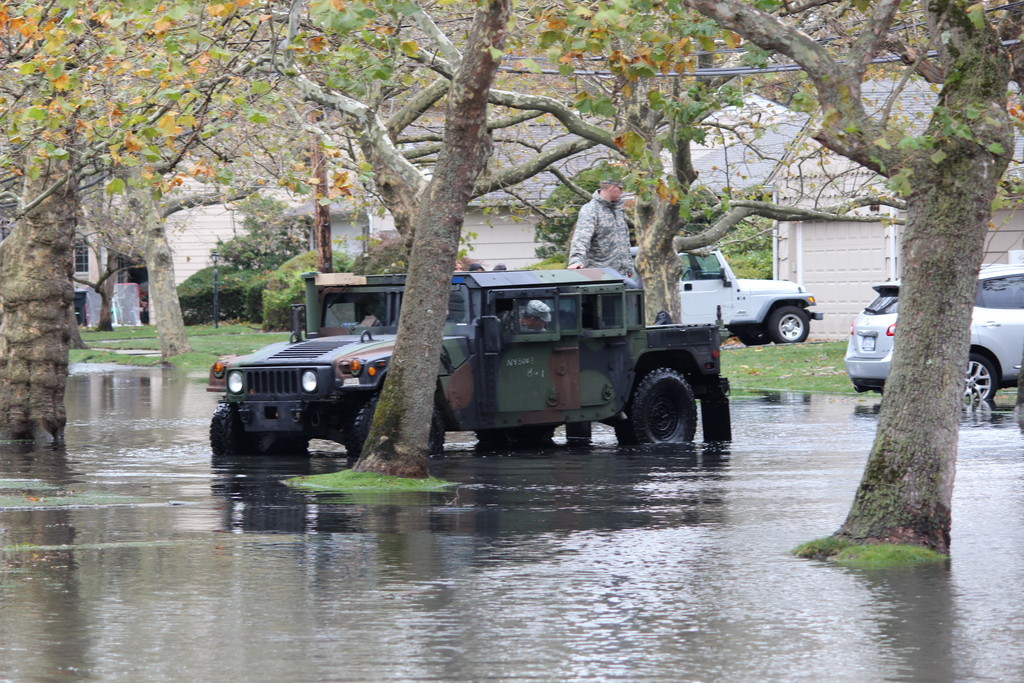Recalling Sandy five years later
Five Towners showed their mettle after the storm
On Oct. 22, 2012, Tropical Depression 18 formed in the Caribbean Sea south of Jamaica, according to the National Weather Service. It intensified, and seven days later Hurricane Sandy struck the metropolitan area, flooding homes, businesses, schools and hospitals as well as the New York City and New Jersey transit systems. Fierce winds flung boats onto nearby lawns. Trees were uprooted. Residents went without power for days.
The Herald took a look back at the days immediately following Sandy with people who helped storm victims, were victims themselves or were tasked with solving the manifold problems the storm created in the Five Towns.
Chabad on the front lines
A week after the hurricane hit the Five Towns, the electricity remained out in many homes because substations that distributed power were flooded. The Chabad of the Five Towns, in Cedarhurst, which had a generator, served as an oasis, offering food, warmth and a place to recharge cell phones and other electronic devices to roughly 2,000 people over a two-week span.
“Reflecting on the hurricane and what I remember really brings back very tough and at the same time beautiful memories,” said Rabbi Zalman Wolowik, the Chabad’s spiritual leader. “Obviously, being in an area that has never experienced a hurricane, and then being thrown into it, was something very new to us, but we recognized that it was our time to act, and definitely not to run from the ‘front lines.’
“Chabad dealt with running a soup kitchen, serving hundreds of meals daily for over two weeks,” Wolowik added. “Miraculously, we had electricity in our center as well as in our home, so many would just come to charge their phones and laptops. Obviously, all enjoyed a hot breakfast, lunch and dinner; our center was open 24 hours a day.
“[We] brought in volunteers from neighboring communities to help people clean out their hurricane-devastated homes,” he continued. “We brought meals to hundreds of homes in our community and surrounding communities. In addition, Chabad set up in its parking lot a large tent, organized like a clothing store, with donations of all-new clothing for men, women and children.
“Many needed financial aid to get things started, and to try and bring some normalcy back to life, we are proud to say thanks to the hard work and coordination of our staff at Chabad, we played a major role in allowing and enabling the community to be able to continue normal life after such devastation.”
Lawrence High School closes
Mott’s Creek overflowed and flooded the Lawrence High School grounds. The Lawrence district closed all of its schools for nearly three weeks, and reopened on Nov. 13.
At the high school, which sustained severe damage to its auditorium, the air quality was monitored for evidence of mold. Saltwater corroded electrical wiring. On Jan. 15, 2013, district officials made the decision to close the high school for eight weeks for repairs.
A plan was devised to move 975 high school students to the middle school. Fifth-graders were moved to the Number Five School, and sixth-graders to the Number Two School. After the district was shut down on Jan. 16 to move equipment and other needed supplies, school resumed on Jan. 17.
Bill Moss, then the district’s math chairman and now its science chairman as well, was tasked with creating the plans. “I remember all of the administrators meeting with Mr. Schall” — then Superintendent Gary Schall — “… with one thought in mind: How do we deal with the immediate closing of the high school?” Moss recalled.
He developed a spreadsheet for the school, typing in every schedule of every seventh- and eighth-grade teacher at the middle school, then superimposing the schedule of every high school teacher, then working out the conflicts to maximize room usage.
Moss said that by midnight of Jan. 17, he and Dr. Jennifer Lagnado, Lawrence High’s principal, had decided to put four classes into the corners of the middle school auditorium temporarily. “It took me about six hours to develop the matrix that interweaved the two buildings,” Moss said. “My goal was to print out the matrix to have it ready for the almost 1,000 high school students the next day.”
The district divided offices to build extra classrooms. “As days went on, we created new classrooms at the direction of Mr. Schall, which allowed me to program classes out of the library and auditorium and into classrooms newly suitable for teaching and learning,” Moss said.
The repaired Lawrence High reopened on April 3, 2013.
Mayors help after storm
Cedarhurst’s deputy village clerk, JoMarie Capone, was in Village Hall with then Mayor Andrew Parise when Sandy hit. “After installing an old-type phone [no electric needed], the mayor was answering the phone at his desk at 11 p.m. and at all hours,” Capone recounted, “which surprised those who called, [and] which they found very comforting.”
“The mayor stayed in Village Hall 24/7 until the storm finally ended, and until 11 p.m. thereafter,” Capone added. “Village Hall was kept open with a small staff. The mayor declared a state of emergency. Unfortunately, there wasn’t much a person can do. Everyone in the surrounding villages and towns were experiencing the same things.
Capone said that Parise had other village employees drive in village cars and the then deputy mayor, Ben Weinstock, and other trustees also patrolled Cedarhurst, along with volunteer residents, to provide some sense of security.
“When possible, the mayor went out and drove the streets — the flood zone portion of the village was hit the hardest,” Capone recalled. “As each day passed by, you’d see entire families hauling furniture, debris, everything out of their houses onto their lawns. It was so devastating. Military trucks came in to help. In all of my years living here, I’ve never seen something like this. My mother died a couple of weeks before this, and I was very relieved that she didn’t have to endure this.
“Meetings were held with the Lawrence-Cedarhurst Fire Department, the 4th Precinct, the auxiliary police, county officials, Sanitary District No. 1, school officials, and with residents,” she said. “A few times a day, conference calls were being held with all of the above, and the Long Island Power Authority, LIPA, Gov. Andrew Cuomo and even the president of the United States.”
According to Capone, the LCFD, the police and Sanitary District No. 1, “went over and above to handle the crisis.” “It was horrible,” she remembered, “it was a very stressful time. The mayor felt helpless, but continued his efforts. Unfortunately, to this day, there are residents in the flood zone of Cedarhurst that are still dealing with the aftermath of Sandy.”
In addition, to his duties as mayor of Lawrence at the time, Martin Oliner and his wife, Reva, helped to established the Disaster Relief Clinic at Touro Law Center in Central Islip in February of 2013.
“I am glad to be able to help fund this worthy endeavor,” Oliner said, previously. “I know that the clinic will have far reaching benefits for families struggling to overcome the endless legal issues that face so many whose lives have been displaced.”
The clinic provides free legal assistance with insurance claims, environmental remediation, government assistance programs including the Federal Emergency Management Agency, insurance and consumer fraud concerns and other legal problems that resulted due to Hurricane Sandy.
Center volunteers have spoken to 5,000 households and represented more than 1,600 unique households, since it opened.
Potential clients can call (631) 761-7198 or email tlcheart@tourolaw.edu.
A young resident remembers
Like many of their Five Towns neighbors, the Balsam family’s North Woodmere home was severely damaged. Five years later, the repairs have been completed, and the sinkholes on the driveway have been filled.
Emma Balsam, now a freshman at Duke University, recalled the storm’s aftermath in a supplementary college entrance essay. “Five foot flood waters engulfed my home and submerged both family cars, cutting all electricity, heat and hot water for five weeks,” she wrote. “As grim as our own situation was, word quickly spread of families whose homes had been completely demolished and were now displaced.
“With schools closed and my parents spending every daylight hour ripping out moldy carpeting and salvaging waterlogged possessions,” Balsam went on, “I was only too glad to immerse myself in relief efforts centralized in Lawrence Middle School, the only public school building in the district left unscathed.
“Several days a week I walked or caught rides with friends and neighbors to help record donations of clothes, diapers, batteries, flashlights, formula, bedding and home-cooked meals that were distributed as quickly as they were received.
After 9/11, we had come to realize that our community was home to a disproportionately high number of veterans and first responders. Post-Sandy, we bonded as a united entity, and every able-bodied person became, in turn, a dedicated first responder.
“The destruction wreaked by Sandy was no match for the limitless compassion and fortitude I witnessed from people who rushed to help others before they could even help themselves,” Balsam wrote. “Our mettle had been tested, and we were not found wanting.”

 47.0°,
Mostly Cloudy
47.0°,
Mostly Cloudy 








